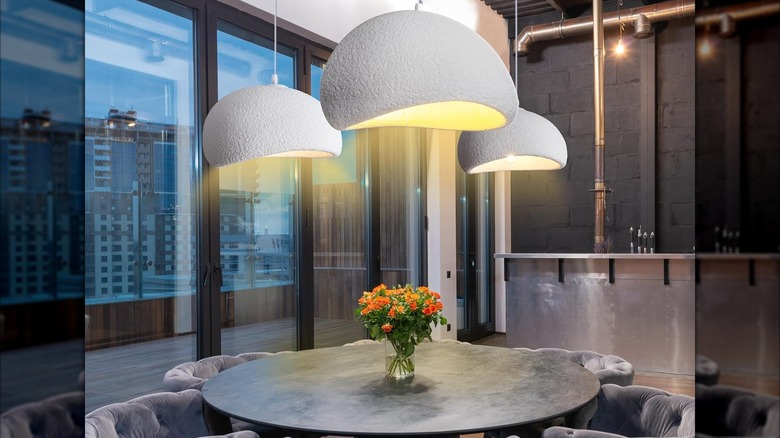The Unique Lighting Fixture Your Dining Room Needs To Hop On The Minimalist Trend
We may receive a commission on purchases made from links.
The sputnik chandeliers that seemed to suddenly illuminate homes in a burst of collective pandemic-time home decor are already orbiting the style wheel. To replace those jagged, spiky, brightly lit ceiling fixtures inspired by the mid-century Atomic Age come minimalist pendant lights in the so-called wabi sabi style. Design experts are quick to point out, however, that wabi sabi isn't as much a style as an approach to life. The amorphous shape of the lights along with their natural, roughly textured shades in muted, earthy colors are said to reflect the wabi sabi worldview, which originated in 16th-century Japanese tea ceremonies and embraces imperfection, simplicity, and nature.
These unique lighting fixtures are finding their way into many spaces of the home, but most especially dining rooms, at prices some find affordable. A 12-inch version from Jughtbo, for instance, is $99, and there are many others on the market and are available in much larger sizes.
The wabi sabi lamp is loved for the quiet mood it can create over all kinds of dining room tables. You'll also see these hanging in groupings of two, three, four, five or even more for the ultimate dining room glow up. Some end up installing these lights very close to the ceiling, which is an aesthetic of its own. As a best practice, however, one of the things to consider before installing a pendant lighting is hanging it between 12- to 20 inches below an 8-foot ceiling for proper ambience.
You'll be surprised what wabi sabi pendant lights are made of
Unboxing a wabi sabi lamp is a thing, and watching will trick the eye. Lights from mass retailers look very heavy, but are oftentimes made with a concrete-looking or cement-imitation finish in synthetic materials such as styrofoam, yet another way to repurpose the material in your home or garden. That's the case even with higher-priced lighting, which can cost hundreds of dollars or $1,000 or more. That's why some have DIYed these lighting fixtures themselves, using materials from craft and dollar stores and what they might have around the house.
There are variations on the process, but it always starts with a balloon. Some prefer the large size and weight of a punching balloon. Bubble wrap, in another genius way the plastic material can improve your home, is taped to the outside of the balloon to build up the shade's blobby shape. Tin foil can also be used. The balloon is then covered in papier-mâché. Additional strips of newspaper can be glued on if sections need shaping. After the papier-mâché has dried, CelluClay to Plaster of Paris are used to create the outside layer, which can be sanded and painted. Some will fortify the inside with more papier-mâché or paint. Once dry over several days, the balloon is popped and removed. Then a hole can be drilled through the top (or side, for an even more unique look), and a pendant light strung through.
